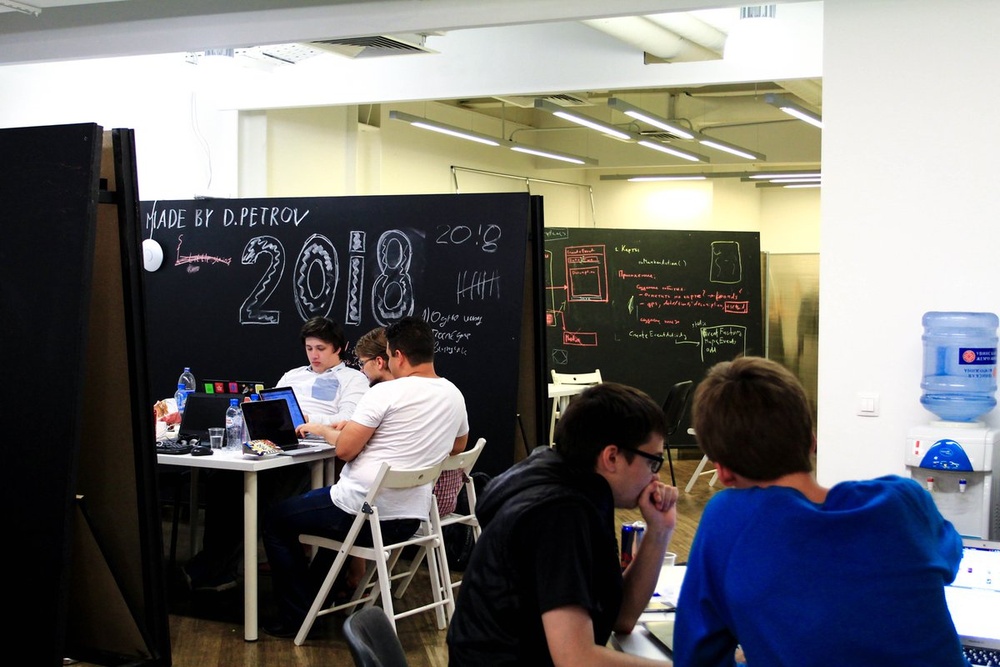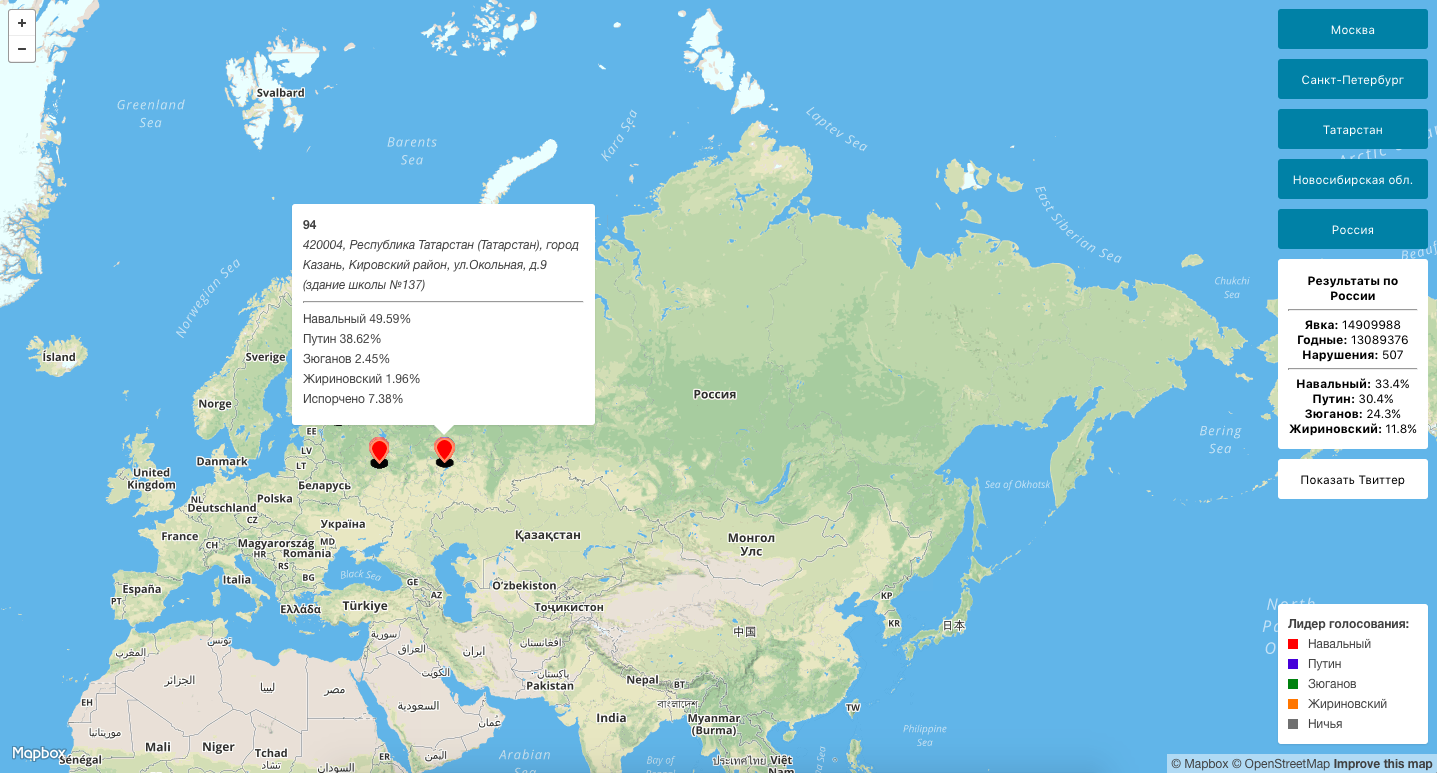Report on the hackathon of the Navalny team
I work in the IT department of the campaign headquarters for the registration of Alexei Navalny as a candidate for the presidential elections in Russia in 2018. We have a small staff of developers, but resources are not always enough to implement all interesting projects and generate fresh ideas.

Therefore, on July 26, we announced a hackathon to create products and tools to help the campaign and its volunteers.
We asked all involved in the creation of IT-projects to offer their ideas projects, and those who did not have them - offered their own. More than 100 applications came in 2 weeks, the vast majority came from developers. Here is the number of applications mentioning various languages / technologies:
')
Python - 27
Javascript - 18
C / C ++ / C # - 17
Java - 16
PHP - 11
Swift / Objective-C - 7
NodeJS - 4
Ruby - 3
Scala - 3
Go - 2
Assembler - 1
This distribution pleased us because our main stack is Python (Django) and JavaScript (jQuery, React).
We gathered all the participants in advance in a general chat in Telegram and started discussing projects and searching for teams. As a result, when on Saturday, August 12, 57 people came to our Moscow and St. Petersburg headquarters, almost all of them already knew with whom and on what task they would work, and some even prepared small prototypes. In total, there were 19 teams that were implementing their ideas on how they can help the campaign for 2 days.
Throughout the hackathon, our IT team leaders and invited experts advised the participants and helped them choose the best solutions. In the final, the teams talked about what they did and showed their prototypes, and the jury (campaign head of the campaign Leonid Volkov , director of FBK Roman Rubanov , creative director of FBK Elena Marus , IT consultant Vladislav Zdolnikov and UX expert Alexey Kopylov ) named 3 winning projects. They were the application Navalny Live, a virtual call center and Telegram-CEC .

Here is a brief description of these and other interesting projects from the hackathon. Links to the githab are included, so if any projects interest you, you can always join in and help the participants to complete it.
We will continue working with these and other teams after the hackathon and will try to release them for wide use as soon as possible. We want to thank those who participated and helped us organize everything, and also invite everyone to join the already started projects and future hackathons of our campaign.

Therefore, on July 26, we announced a hackathon to create products and tools to help the campaign and its volunteers.
We asked all involved in the creation of IT-projects to offer their ideas projects, and those who did not have them - offered their own. More than 100 applications came in 2 weeks, the vast majority came from developers. Here is the number of applications mentioning various languages / technologies:
')
Python - 27
Javascript - 18
C / C ++ / C # - 17
Java - 16
PHP - 11
Swift / Objective-C - 7
NodeJS - 4
Ruby - 3
Scala - 3
Go - 2
Assembler - 1
This distribution pleased us because our main stack is Python (Django) and JavaScript (jQuery, React).
We gathered all the participants in advance in a general chat in Telegram and started discussing projects and searching for teams. As a result, when on Saturday, August 12, 57 people came to our Moscow and St. Petersburg headquarters, almost all of them already knew with whom and on what task they would work, and some even prepared small prototypes. In total, there were 19 teams that were implementing their ideas on how they can help the campaign for 2 days.
Throughout the hackathon, our IT team leaders and invited experts advised the participants and helped them choose the best solutions. In the final, the teams talked about what they did and showed their prototypes, and the jury (campaign head of the campaign Leonid Volkov , director of FBK Roman Rubanov , creative director of FBK Elena Marus , IT consultant Vladislav Zdolnikov and UX expert Alexey Kopylov ) named 3 winning projects. They were the application Navalny Live, a virtual call center and Telegram-CEC .

Here is a brief description of these and other interesting projects from the hackathon. Links to the githab are included, so if any projects interest you, you can always join in and help the participants to complete it.
- The application Navalny Live will allow you to listen to live broadcasts from our YouTube channel and recording. The team managed to set up a server that is ready to receive an RTMP stream from the studio and distribute it to users, api to receive metadata about broadcasts and an iOS application.
- A virtual call center (or, as we call it, “Cloud Calling”) is a system with which each volunteer can call the voter and agitate him to vote for our candidate. It will also show the user a conversation script offered by headquarters. The basis is the computer telephony system Asterisk.
- Telegram-CEC is a logical development of the project of the association “Voice” SMS-CEC . It will allow to collect preliminary results of the election from observers, as well as collect a single base of violations and monitor the situation on election day across the country on a map in real time.

navalny-observer.herokuapp.com - The bot detector detects from a comment from any social network the probability that its author is an inhabitant of Olgino . We plan to actively use it in the fight for the purity of the Internet.
- The map of the floor bypass is a system for door-to-door agitation. It shows the campaign coverage of each region and area, allows the volunteer to sign up for a bypass of a specific entrance and report on the work done through a telegram-bot.
- On the Navalny website, everyone will be able to find a video answer from our candidate to their question, add a question that has not yet been asked, or a video with an answer that has not yet been added.
- In the Pulse application, participants propose to implement the functionality of the Red Button , which notifies all our supporters in a small radius around the user that something is happening to him (both good and unpleasant) and inviting them to join.
We will continue working with these and other teams after the hackathon and will try to release them for wide use as soon as possible. We want to thank those who participated and helped us organize everything, and also invite everyone to join the already started projects and future hackathons of our campaign.
Source: https://habr.com/ru/post/335778/
All Articles